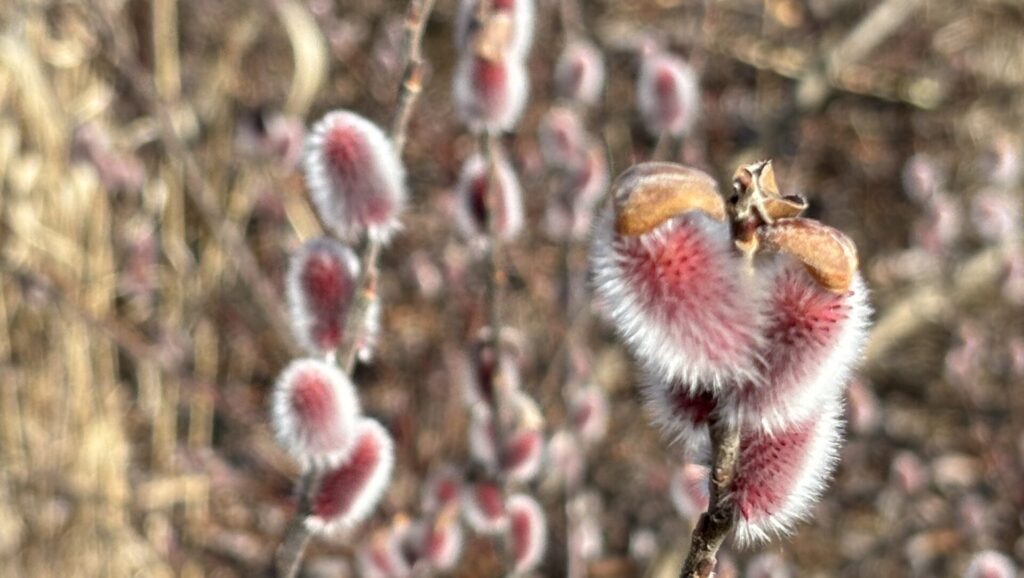
The Salix genus encompasses over 350 different species plus many hybrids, consisting of deciduous trees and shrubs that are found growing in primarily moist soils in temperate and cold regions. Willows are generally dioecious, meaning that males and females are separate plants. Flowers appear as catkins (noted to resemble furry cat feet) and are produced in late winter to early spring before foliage emerges. Willows are among the earliest woody plants to leaf out each spring (sometimes as early as February in some regions) with simple leaves in various shades of green. The bark from certain species of willow (notably S. alba) contain a medicinally important chemical compound called salicin which is similar to aspirin with its pain relieving properties.
 Pussy willow is the name given to numerous smaller willow species in the genus when their velvety upright catkins appear on leafless stems in late winter and early spring. The appearance of these catkins are one of spring’s earliest harbingers! The male trees produce white-silver catkins earlier than the female trees, before tiny pollen-laced flowers appear. The female catkins receive the males’ pollen from bees (notably the cellophane bee) and fly species. The soft and fuzzy coating of these catkins acts as insulation keeping the plants’ reproductive parts protected. Some hummingbirds may even use this fluff as nest components! Pussy willows are generally fast-growing and can reach heights up to 25 feet depending on the species. Most North American native species are found in wetland habitats and thus will do well in yards with poor-draining soil. Willows tend to be weak and brittle, so proper pruning techniques are helpful to mitigate snow and ice damage.
Pussy willow is the name given to numerous smaller willow species in the genus when their velvety upright catkins appear on leafless stems in late winter and early spring. The appearance of these catkins are one of spring’s earliest harbingers! The male trees produce white-silver catkins earlier than the female trees, before tiny pollen-laced flowers appear. The female catkins receive the males’ pollen from bees (notably the cellophane bee) and fly species. The soft and fuzzy coating of these catkins acts as insulation keeping the plants’ reproductive parts protected. Some hummingbirds may even use this fluff as nest components! Pussy willows are generally fast-growing and can reach heights up to 25 feet depending on the species. Most North American native species are found in wetland habitats and thus will do well in yards with poor-draining soil. Willows tend to be weak and brittle, so proper pruning techniques are helpful to mitigate snow and ice damage.
Salix gracilistyla ‘Mt. Aso’ (Japanese pink pussy willow)

The most colorful pussy willow variety in the Arboretum’s collections is S. gracilistyla, commonly known as rose-gold pussy willow, and it is on display now. It has many similar qualities to other pussy willows, however, it is native to Japan, China, and Korea. The specific epithet (gracilistyla), means slender style, referring to its smaller bushy form growing between 6-10’ tall. Green oval leaves are tinged with blue and silver beneath. ‘Mt. Aso’ (sometimes referred to as ‘Mt. Asama’) is a cultivar named after Mount Aso-san, which is Japan’s most active volcano. The most striking feature is its large and vibrant rosy-pink catkins. These form on second-year wood and are sure to enliven the winter landscape with an early spring display! If left on the plant, the furry catkins will turn black and gold after about a few weeks. This selection, unsurprisingly, is very popular in the cut flower trade in Japan.
‘Mt. Aso’ can be found in our Marsh Meadow, not too far from the meadow boardwalk that leads to campus. You can find the exact location of these plants in the gardens by searching ‘Salix’ on the Arboretum Plant Finder!

